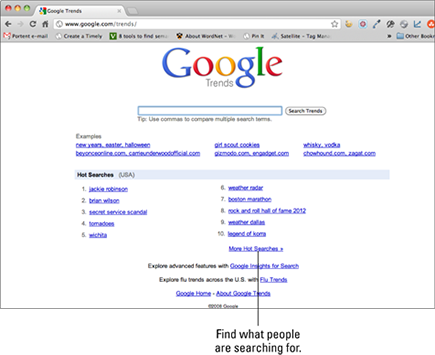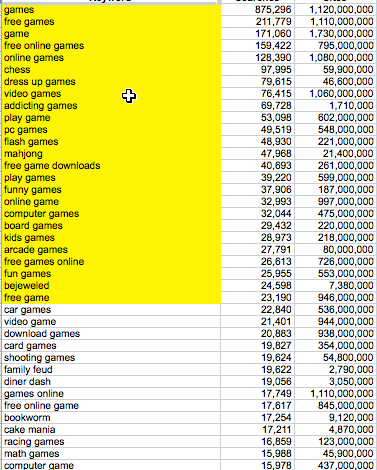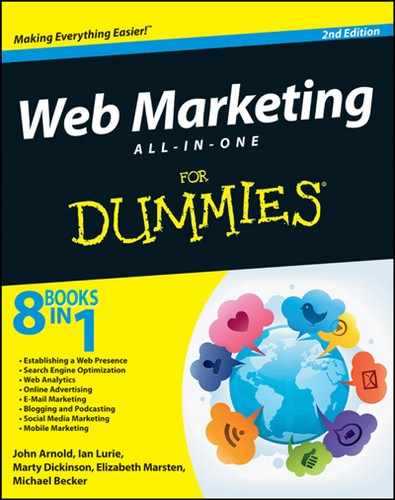Chapter 2: Choosing the Right Keywords
In This Chapter
![]() Picking keywords that your visitors (not you) want
Picking keywords that your visitors (not you) want
![]() Discovering keyword tools
Discovering keyword tools
![]() Using the right selection criteria
Using the right selection criteria
![]() Researching your competitors
Researching your competitors
At some point, not talking about keywords in regards to SEO is the dream. The truth is, keywords aren’t the focus of a good SEO strategy — visibility, authority, and good writing are.
But you still want to focus on keywords. Search engines haven’t gotten good enough at semantics to make us all forget about keywords. Someday search engines may be able to index and rank sites based on concepts — by knowing that cars and autos are the same thing — but until then, you have to make some pretty specific choices.
In this chapter, you find out how to pick the right keywords to bring traffic to your business website. Don’t drive yourself crazy with keyword research. Your time is better spent on writing great stuff, working in social media, and improving your site. But some basic research always helps.
Thinking Like Your Visitors
Before you start thinking about tools, you must understand that you are not optimizing for the keywords you like or think should be associated with your product or service. You are optimizing for the keywords that potential customers associate with your product or service.
For example, say that you sell salad through the Internet. You’ve found a miraculous way to keep vegetables crisp and prevent lettuce from wilting, and you ship salad to suburban dwellers everywhere.
You research keywords and find that no one searches for salad. They search for mixed greens instead. You have a choice to make. You can insist on optimizing for salad, because that is what you sell. Or, you can optimize for mixed greens, get visitors, and then educate them as to why salad is better.
Understanding the Long Tail
You never optimize for a single word; you optimize for a keyword and the hundreds or thousands of permutations on that word. So, if you’re targeting broccoli, you’re probably also targeting cream of broccoli soup, broccoli recipes, and broccoli coleslaw. These long-tail phrases — longer niche phrases that don’t get as many searches — are the real beauty of search engine optimization. By optimizing for one word or phrase, you get the benefit of improved rankings for many more.
Go back to the salad example from the preceding section. You decide to optimize for mixed greens. After six months of hard work, you’re still stuck on the fourth rankings page for that phrase. But your traffic from organic searches has gone up 300 percent. For these reasons, you’re not sure whether you should fire yourself or give yourself a raise.
Taking a look at your traffic report, though, you notice something interesting. Traffic from longer phrases that include the words mixed greens has gone up. Phrases such as the following are now major traffic generators:
mixed spring greens mixed greens online buy mixed greens mixed greens salads really great mixed greens where can I buy mixed greens
All these phrases are driving traffic to your site. Together, the six phrases drive more traffic than mixed greens would have.
Behold, the long tail! By optimizing for one phrase, you really optimized for six longer ones. Even though you didn’t move up in the rankings for the target phrase, you did move up for these others, and they brought you traffic.
Long-tail phrases work for two reasons:
• You can optimize for many of them at once by focusing on one shorter phrase.
• Searchers that visit your website from long-tail phrases are generally better targeted and better customers. If folks comes to your website from a long-tail search result and you have what they want, they’re likely to buy.
So the next time you’re sweating bullets, staring at your rankings report and wondering why you haven’t moved up, check your traffic report, too. The long tail might pay off big.
Finding the Right Tools
Luckily, you don’t have to guess to find keywords. You can use some of the great tools available to help you with your initial brainstorming.
Using keyword services
Several companies have launched keyword services designed just for search engine optimization pros looking for the right targets. These services include the following:
• SEMRush: www.semrush.com
• Keyword Discovery: http://keyworddiscovery.com
• Wordtracker: www.wordtracker.com
All services cost a small monthly fee, but they are a good investment. They provide at-a-glance reports showing keyword demand, competition, and quality, as shown in Figure 2-1.
Figure 2-1: SEMRush gives you insight into competitors and search volume and whether you can compete.

Working with the Google AdWords keyword research tool
The Google AdWords keyword tool is the only source for Google keyword search data. It’s not perfect, but it’s what you have.
To show search volumes, follow these steps:
1. Go to http://adwords.google.com/select/KeywordToolExternal.
2. Type a phrase in the text box, and click the Get Keyword Ideas button.
The report you receive, shown in Figure 2-2, shows searches performed in the previous month, average monthly search volume over the past 12 months, and advertiser competition in Google AdWords.
3. Click the Columns option list and then choose Local Search Trends, as shown in Figure 2-3.
Doing this adds an additional column to the report. You see trended search data by month.
Figure 2-2: Using the Google AdWords keyword tool.

Figure 2-3: Viewing the search trends data.

Be sure to try these other options:
• You can change the Match Type. By default, the Adwords keyword tool gives you search counts based on a Broad match. You might want to set the Match Type to Exact, to make sure that you don’t get too excited about search volumes. See Book IV, Chapter 3 to find out more.
• You can also get keyword ideas based on a website’s content. Click Website Content and enter a web address. Google’s tool checks the page and pulls keywords based on the words and phrases on that page. The Website Content option is a great way to get ideas for keywords you hadn’t thought of. You can also verify that your page is optimized for the right phrases and check competitors’ pages.
Using Google Trends
All major search engines favor content that focuses on hot key phrases. For example, say that a famous movie star loses 45 pounds on a diet solely composed of mixed greens. The story hits newsstands, and suddenly everyone is searching for mixed greens diet.
If you knew that, you could add a few articles to your site about the mixed greens diet. The search engines would see that and quickly move you up in the rankings. You’d get a nice burst of traffic.
If only you had a way to check on trending phrases. . . .
Oh, but wait, you do! Google Trends. Follow these steps:
1. Go to www.google.com/trends.
2. Type any phrase and click the Search Trends button.
You can see whether search volumes are rising or falling. The report even shows specific news stories and whether they affected search volumes.
The top section is the search volume index, the rise or fall in searches for that phrase. The bottom section is the news reference volume, which tells you online media mentions of the phrase.
You can get more advanced reporting at www.google.com/insights/search, including seasonality, geography, and categories.
You can see a list of the top 100 hot phrases by clicking the More Hot Searches link, as shown in Figure 2-4.
Figure 2-4: Clicking the More Hot Searches link produces the top 100 phrases.

Watching the news
We are media driven. It pays to keep current on TV, radio, and print news. If a relevant story seems to be gaining a lot of ground, work it into your website.
Going back to the (now somewhat silly) mixed greens example earlier in this chapter: If you see on the news that Mark Starguy is the movie star who lost 45 pounds on the mixed greens diet, you might want to mention his name here and there. Chances are that other folks watching the news will remember the star’s name and diet, but not mixed greens. If you show up for Mark Starguy diet, you’re set.
Using your brain
All the computers in the world can’t match your brain for its ability to manipulate language. Don’t rely on keyword tools alone. They will eventually lie to you (or at least tell a small fib): Keyword tools lack your insight into your customers. They can use only the data they have, and that means sometimes they’ll miss important subtleties, such as the difference between auto (as in automobile) and auto (as in automatic).
Picking Great Keywords
After you decide what tools to use, it helps to know the criteria for choosing a great keyword. You need to judge relevance, competition, and value.
Looking for opportunity
If you use only one rule for keyword research, it’s this: Find the opportunity gaps.
Look at your own traffic reports. Do any phrases drive quality traffic right now, but could still drive more? Start there. It’s easier to go from #10 to #8 than it is to go from #100 to #1. But so many business owners try to rank for the toughest terms first.
If you want to rank #1 for diamond rings, more power to you. You might manage it someday. But find the terms that might generate more sales and traffic for you in the meantime.
Judging keyword relevance
Question whether the keyword you found is really relevant to your business. For example, mixed greens could mean mixed greens for salad. It could also mean mixed green paint.
After you choose a keyword, test it by using all the tools listed in the “Finding the Right Tools” section, earlier in this chapter. Make sure that you don’t see any equally correct but totally irrelevant meanings creeping into the search results.
Comparing competition and search volume
If you’re facing 200 million other websites that are all vying for the No. 1 spot, you might want to choose a different keyword.
Go to Google and Bing and search for the phrase you’ve chosen. Look at three competitive factors:
• The number of competing sites: If you find more than 10 million competing pages in the search results, you might be facing an uphill battle.
• Where you rank: If you’re already on the second page of the results, you might not care how many sites are competing with you.
• Your ability to compete: If you have a daily newsletter on your site about mixed greens, you might be super competitive, even if a mob of other sites are trying to beat you. You’re adding new, highly relevant content every day, and search engines love that. That steady content growth gives you an advantage.
Your best strategy is to mix your keyword list and optimize for both of the following:
• High-volume, high-competition keywords that require a long effort on your part before you gain any rankings
• Low-volume, low-competition keywords that can produce results sooner
This strategy lets you build traffic sooner while still aiming for the home run phrases later.
Checking your industry with Google Insights
You can also make sure that the keyword you chose fits your industry. (Are you offering mixed greens or mixed green paint?) You can use Google Insights to double-check your assumptions about your keyword’s relevancy by following these steps:
1. Go to www.google.com/insights/search and type your keyword in the text box.
2. Click the All Categories drop-down list and choose a category your keyword fits in, and then click the Search button.
Pshew. Looks like mixed greens really is about leafy stuff.
3. If you’re still worried, select a category you don’t expect your keyword to fall into.
If you get a result of “Not enough search volume to show graphs,” you know that you’re in good shape.
Testing with pay per click
Because a search engine optimization campaign can take months to really affect your business, you may want to test your keywords by using a faster method — pay-per-click (PPC) marketing.
Because you can start and end a PPC campaign in a matter of minutes, doing so is a great way to get a rough idea of keyword viability.
Building Your Keyword List
As you select keywords, keep track of them using a spreadsheet like the one shown in Figure 2-5.
Figure 2-5: Keep a keyword spreadsheet to help you remember selections.

Keeping a spreadsheet can help you remember which keywords you selected, which ones you ignored, and why.
Sizing Up the Competition
Always keep your eyes on the competition. If they’re smart, they’re keeping their eyes on you, too. Watch how your competitors rank for particular keywords, watch what they’re doing to try to beat you in the rankings, and always look for places where you have an advantage. SEO is a zero-sum game: Only one No. 1 spot exists. So make sure that you’re always tracking competitors.
Finding your keyword competitors
Hopefully, who your competitors are isn’t a mystery. Go to Google and Bing and search for your target keywords. Consider the top-ten sites to be your primary competitors.
Use some of the tools covered in Chapter 1 of this minibook to find out about your competitors. Use the following:
• SeoQuake tells you how many links your competitors have, shows you their keyword density, and shows how many pages they have in the respective search engine indexes.
• SEOMOZ’s opensiteexplorer.org and Majestic’s majesticseo.com can both provide priceless intelligence regarding links and site authority.
Discovering your competitors’ weaknesses
Several of the top-ten sites for a specific phrase probably aren’t doing a very good job of optimizing their websites. They’re in the top ten by luck or because no one else has done much SEO either.
You need to find those sites’ weaknesses. If you can optimize your site better than they can, you have a good shot at replacing them in the rankings.
Use SeoQuake to see whether you can increase the keyword density — the percentage of total page text occupied by your key phrase — for target phrases on your site. Going above 5 to 7 percent keyword density isn’t necessary. But if your competitors have 200 words on a page and 10 instances of a phrase, you can certainly put 250 words on a page and have 15 instances of the same phrase.
Use the Web Developer toolbar to see whether your competitors have built a good relevance hierarchy on their sites. If they don’t have the target key phrase or a related phrase in their title tags or headings, you can get a huge advantage by putting the phrase in those elements.
Figure out where your competitors have fallen down on the job. It’s not magic. The vast majority of websites do a horrible job of SEO. Research the basics, and you can probably find lots of ways to outrank them.
Ignoring your competition
The vast majority of sites do a horrible job of SEO. If a keyword you selected looks just fantastic, but none of your competitors are using it, it might be their problem, not yours. What if all your competitors insist on optimizing for salad, even though no one searches for it?

 Don’t try to shove your own beliefs about your product or service down the throats of your customers by picking the keywords
Don’t try to shove your own beliefs about your product or service down the throats of your customers by picking the keywords  If a customer searches for
If a customer searches for 
 Always balance competition against search volume. Some terms might be so relevant and offer so many potential visitors that any level of competition is worth it. For example, the phrase
Always balance competition against search volume. Some terms might be so relevant and offer so many potential visitors that any level of competition is worth it. For example, the phrase